您好,登錄后才能下訂單哦!
您好,登錄后才能下訂單哦!
一、整合原理
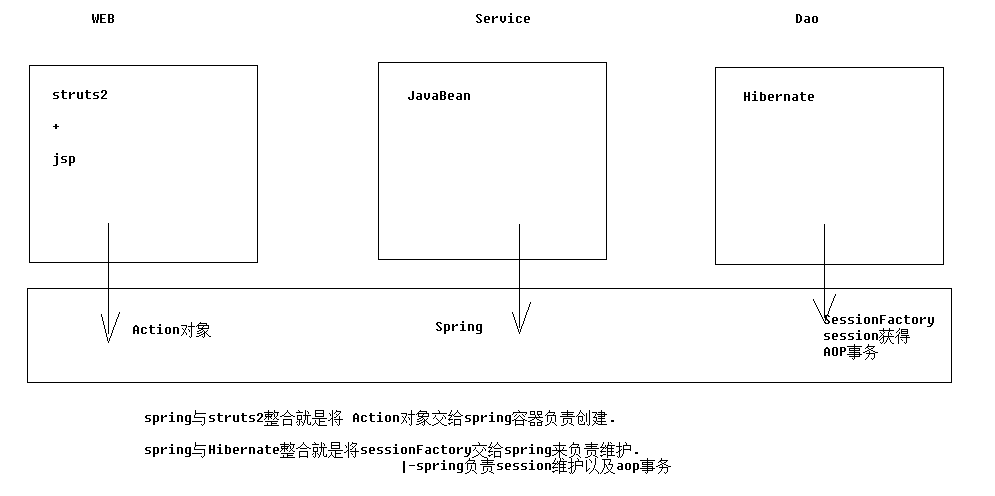
二、導包(41個)
1.hibernate
(1)hibernate/lib/required
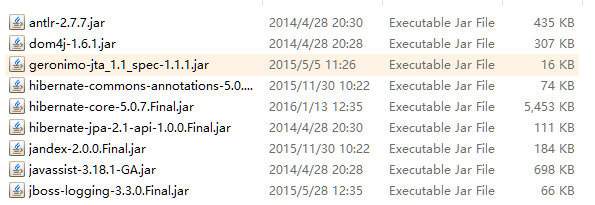
(2)hibernate/lib/jpa | java persist api java的持久化規范(接口)

(3)數據庫驅動

2.struts2
(1)struts-blank.war/WEB-INF/lib/*
注意:javassist-3.18.1-GA.jar包與hibernate中的重復(只保留高版本即可)
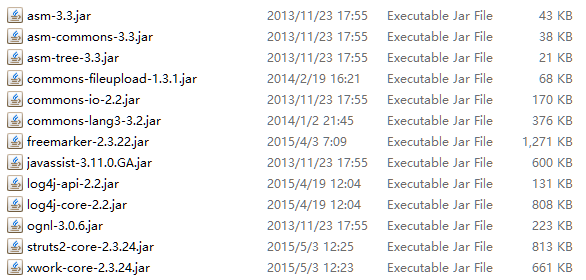
(2)struts整合spring插件包
注意:這個包一旦導入,那么struts2在啟動時就會尋找spring容器.找不到將會拋出異常

3.spring
(1)基本:4+2
core | beans | context | expression | logging | log4j
(2)整合web:web包
spring-web
(3)整合aop:4個
spring-aop | spring-aspect | aop聯盟 | aopweaving
(4)整合Hibernate和事務:4個
spring-jdbc | spring-tx | c3p0 | spring-orm
(5)整合junit4測試:test包
spring-test
4.標簽庫
standard.jar | jstl-1.2.jar
三、單獨配置spring容器
1.創建applicationContext.xml,并導入約束(4個) beans | context | aop | tx

<?xml version="1.0" encoding="UTF-8"?>
<beans xmlns:xsi="http://www.w3.org/2001/XMLSchema-instance"
xmlns="http://www.springframework.org/schema/beans"
xmlns:context="http://www.springframework.org/schema/context"
xmlns:aop="http://www.springframework.org/schema/aop"
xmlns:tx="http://www.springframework.org/schema/tx"
xsi:schemaLocation="http://www.springframework.org/schema/beans http://www.springframework.org/schema/beans/spring-beans-4.2.xsd
http://www.springframework.org/schema/context http://www.springframework.org/schema/context/spring-context-4.2.xsd
http://www.springframework.org/schema/aop http://www.springframework.org/schema/aop/spring-aop-4.2.xsd
http://www.springframework.org/schema/tx http://www.springframework.org/schema/tx/spring-tx-4.2.xsd ">
<bean name="userAction" class="cn.xyp.web.action.UserAction"></bean>
</beans>
2.配置spring隨項目啟動(web.xml)
<!-- 讓spring隨web啟動而創建的監聽器 --> <listener> <listener-class>org.springframework.web.context.ContextLoaderListener</listener-class> </listener> <!-- 配置spring配置文件位置參數 --> <context-param> <param-name>contextConfigLocation</param-name> <param-value>classpath:applicationContext.xml</param-value> </context-param>
四、單獨配置struts2
1.配置struts2主配置文件(struts.xml)
<?xml version="1.0" encoding="UTF-8"?>
<!DOCTYPE struts PUBLIC
"-//Apache Software Foundation//DTD Struts Configuration 2.3//EN"
"http://struts.apache.org/dtds/struts-2.3.dtd">
<struts>
<package name="crm" namespace="/" extends="struts-default">
<action name="UserAction_*" class="cn.xyp.web.action.UserAction" method="{1}">
<result name="success">/success.jsp</result>
</action>
</package>
</struts>
2.配置struts2核心過濾器到web.xml
<!-- struts2核心過濾器 --> <filter> <filter-name>struts2</filter-name> <filter-class>org.apache.struts2.dispatcher.ng.filter.StrutsPrepareAndExecuteFilter</filter-class> </filter> <filter-mapping> <filter-name>struts2</filter-name> <url-pattern>/*</url-pattern> </filter-mapping>
五、struts2與spring整合
1.導包(已經導入)
struts2-spring-plugin-2.3.24.jar
2.配置常量
查看默認配置文件從31行開始找到要配置的變量。
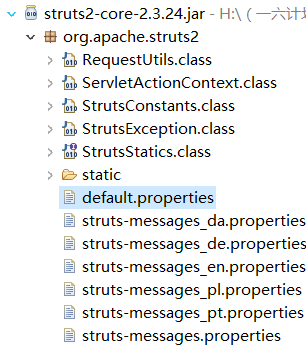
### if specified, the default object factory can be overridden here ### Note: short-hand notation is supported in some cases, such as "spring" ### Alternatively, you can provide a com.opensymphony.xwork2.ObjectFactory subclass name here # struts.objectFactory = spring ### specifies the autoWiring logic when using the SpringObjectFactory. ### valid values are: name, type, auto, and constructor (name is the default) struts.objectFactory.spring.autoWire = name
添加常量到struts.xml
<!-- # struts.objectFactory = spring 將action的創建交給spring容器
struts.objectFactory.spring.autoWire = name spring負責裝配Action依賴屬性
-->
<constant name="struts.objectFactory" value="spring"></constant>
3.整合方案1:struts2自己創建action,spring負責組裝依賴屬性(了解)
<!-- 整合方案1:class屬性上仍然配置action的完整類名
struts2仍然創建action,由spring負責組裝Action中的依賴屬性
-->
<action name="UserAction_*" class="cn.xyp.web.action.UserAction" method="{1}" >
<result name="toHome" type="redirect" >/index.htm</result>
<result name="error" >/login.jsp</result>
</action>
不推薦理由:最好由spring完整管理action的生命周期.spring中功能才應用到Action上.
4.整合方案2:spring負責創建action以及組裝.(推薦)
applicationContext.xml:
<!-- action -->
<!-- 注意:Action對象作用范圍一定是多例的.這樣才符合struts2架構 -->
<bean name="userAction" class="cn.itcast.web.action.UserAction" scope="prototype" >
<property name="userService" ref="userService" ></property>
</bean>
struts.xml:
<!--
整合方案2:class屬性上填寫spring中action對象的BeanName
完全由spring管理action生命周期,包括Action的創建
注意:需要手動組裝依賴屬性
-->
<action name="UserAction_*" class="userAction" method="{1}" >
<result name="toHome" type="redirect" >/index.htm</result>
<result name="error" >/login.jsp</result>
</action>
六、單獨配置hibernate
1.導入實體類&orm元數據
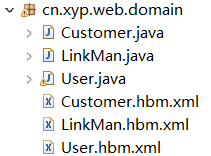
舉例:User.java
package cn.xyp.web.domain;
import java.util.HashSet;
import java.util.Set;
public class User {
private Long user_id;
private String user_code;
private String user_name;
private String user_password;
private Character user_state;
public Long getUser_id() {
return user_id;
}
public void setUser_id(Long user_id) {
this.user_id = user_id;
}
public String getUser_code() {
return user_code;
}
public void setUser_code(String user_code) {
this.user_code = user_code;
}
public String getUser_name() {
return user_name;
}
public void setUser_name(String user_name) {
this.user_name = user_name;
}
public String getUser_password() {
return user_password;
}
public void setUser_password(String user_password) {
this.user_password = user_password;
}
public Character getUser_state() {
return user_state;
}
public void setUser_state(Character user_state) {
this.user_state = user_state;
}
@Override
public String toString() {
return "User [user_id=" + user_id + ", user_code=" + user_code + ", user_name=" + user_name + ", user_password="
+ user_password + "]";
}
}
User.hbm.xml:
<?xml version="1.0" encoding="UTF-8"?>
<!DOCTYPE hibernate-mapping PUBLIC
"-//Hibernate/Hibernate Mapping DTD 3.0//EN"
"http://www.hibernate.org/dtd/hibernate-mapping-3.0.dtd">
<hibernate-mapping package="cn.xyp.domain" >
<class name="User" table="sys_user" >
<id name="user_id" >
<generator class="native"></generator>
</id>
<property name="user_code" ></property>
<property name="user_name" ></property>
<property name="user_password" ></property>
<property name="user_state" ></property>
</class>
</hibernate-mapping>
2.配置主配置文件(hibernate.xml)
<?xml version="1.0" encoding="UTF-8"?>
<!DOCTYPE hibernate-configuration PUBLIC
"-//Hibernate/Hibernate Configuration DTD 3.0//EN"
"http://www.hibernate.org/dtd/hibernate-configuration-3.0.dtd">
<hibernate-configuration>
<session-factory>
<!-- 數據庫驅動 -->
<property name="hibernate.connection.driver_class">com.mysql.jdbc.Driver</property>
<!-- 數據庫url -->
<property name="hibernate.connection.url">jdbc:mysql:///crm_32</property>
<!-- 數據庫連接用戶名 -->
<property name="hibernate.connection.username">root</property>
<!-- 數據庫連接密碼 -->
<property name="hibernate.connection.password">1234</property>
<!-- 數據庫方言
注意: MYSQL在選擇方言時,請選擇最短的方言.
-->
<property name="hibernate.dialect">org.hibernate.dialect.MySQLDialect</property>
<!-- 將hibernate生成的sql語句打印到控制臺 -->
<property name="hibernate.show_sql">true</property>
<!-- 將hibernate生成的sql語句格式化(語法縮進) -->
<property name="hibernate.format_sql">true</property>
<!--
自動導出表結構. 自動建表
-->
<property name="hibernate.hbm2ddl.auto">update</property>
<!-- 引入實體配置文件 -->
<mapping resource="cn/xyp/domain/Customer.hbm.xml" />
<mapping resource="cn/xypt/domain/LinkMan.hbm.xml" />
<mapping resource="cn/xyp/domain/User.hbm.xml" />
</session-factory>
</hibernate-configuration>
七、spring整合hibernate
1.整合原理
將sessionFactory對象交給spring容器管理
2.在spring中配置sessionFactory
(1)配置方案一:(了解)
<!-- 加載配置方案1:仍然使用外部的hibernate.cfg.xml配置信息 -->
<bean name="sessionFactory" class="org.springframework.orm.hibernate5.LocalSessionFactoryBean" >
<property name="configLocation" value="classpath:hibernate.cfg.xml" ></property>
</bean>
(2)配置方案二:(推薦)
<!-- 加載配置方案2:在spring配置中放置hibernate配置信息 -->
<bean name="sessionFactory" class="org.springframework.orm.hibernate5.LocalSessionFactoryBean" >
<!-- 將連接池注入到sessionFactory, hibernate會通過連接池獲得連接 -->
<property name="dataSource" ref="dataSource" ></property>
<!-- 配置hibernate基本信息 -->
<property name="hibernateProperties">
<props>
<!-- 必選配置 -->
<prop key="hibernate.connection.driver_class" >com.mysql.jdbc.Driver</prop>
<prop key="hibernate.connection.url" >jdbc:mysql:///crm_32</prop>
<prop key="hibernate.connection.username" >root</prop>
<prop key="hibernate.connection.password" >1234</prop>
<prop key="hibernate.dialect" >org.hibernate.dialect.MySQLDialect</prop>
<!-- 可選配置 -->
<prop key="hibernate.show_sql" >true</prop>
<prop key="hibernate.format_sql" >true</prop>
<prop key="hibernate.hbm2ddl.auto" >update</prop>
</props>
</property>
<!-- 引入orm元數據,指定orm元數據所在的包路徑,spring會自動讀取包中的所有配置 -->
<property name="mappingDirectoryLocations" value="classpath:cn/itcast/domain" ></property>
</bean>
八、spring整合c3p0連接池
1.配置db.properties
jdbc.jdbcUrl=jdbc:mysql:///xyp_crm jdbc.driverClass=com.mysql.jdbc.Driver jdbc.user=root jdbc.password=123456
2.引入連接池到spring中
<!-- 讀取db.properties文件 -->
<context:property-placeholder location="classpath:db.properties" />
<!-- 配置c3p0連接池 -->
<bean name="dataSource" class="com.mchange.v2.c3p0.ComboPooledDataSource" >
<property name="jdbcUrl" value="${jdbc.jdbcUrl}" ></property>
<property name="driverClass" value="${jdbc.driverClass}" ></property>
<property name="user" value="${jdbc.user}" ></property>
<property name="password" value="${jdbc.password}" ></property>
</bean>
3.將連接池注入給SessionFactory
<bean name="sessionFactory" class="org.springframework.orm.hibernate5.LocalSessionFactoryBean" >
<!-- 將連接池注入到sessionFactory, hibernate會通過連接池獲得連接 -->
<property name="dataSource" ref="dataSource" ></property>
九、spring整合hibernate環境操作數據庫
1.Dao類創建:繼承HibernateDaoSupport
注意:項目中要確保使用統一版本。

//HibernateDaoSupport 為dao注入sessionFactory
public class UserDaoImpl extends HibernateDaoSupport implements UserDao {
2.hibernate模板的操作
(1)execute
@Override
public User getByUserCode(final String usercode) {
//HQL
return getHibernateTemplate().execute(new HibernateCallback<User>() {
@Override
public User doInHibernate(Session session) throws HibernateException {
String hql = "from User where user_code = ? ";
Query query = session.createQuery(hql);
query.setParameter(0, usercode);
User user = (User) query.uniqueResult();
return user;
}
});
(2)findByCriteria
//Criteria
DetachedCriteria dc = DetachedCriteria.forClass(User.class);
dc.add(Restrictions.eq("user_code", usercode));
List<User> list = (List<User>) getHibernateTemplate().findByCriteria(dc);
if(list != null && list.size()>0){
return list.get(0);
}else{
return null;
}
3.spring中配置dao
<!-- Dao -->
<bean name="userDao" class="cn.xyp.dao.impl.UserDaoImpl" >
<!-- 注入sessionFactory -->
<property name="sessionFactory" ref="sessionFactory"></property>
</bean>
十、spring的aop事務
1.準備工作
<!-- 核心事務管理器 -->
<bean name="transactionManager" class="org.springframework.orm.hibernate5.HibernateTransactionManager" >
<property name="sessionFactory" ref="sessionFactory" ></property>
</bean>
2.xml配置aop事務
(1)配置通知
<!-- 配置通知 -->
<tx:advice id="txAdvice" transaction-manager="transactionManager" >
<tx:attributes>
<tx:method name="save*" isolation="REPEATABLE_READ" propagation="REQUIRED" read-only="false" />
<tx:method name="persist*" isolation="REPEATABLE_READ" propagation="REQUIRED" read-only="false" />
<tx:method name="update*" isolation="REPEATABLE_READ" propagation="REQUIRED" read-only="false" />
<tx:method name="modify*" isolation="REPEATABLE_READ" propagation="REQUIRED" read-only="false" />
<tx:method name="delete*" isolation="REPEATABLE_READ" propagation="REQUIRED" read-only="false" />
<tx:method name="remove*" isolation="REPEATABLE_READ" propagation="REQUIRED" read-only="false" />
<tx:method name="get*" isolation="REPEATABLE_READ" propagation="REQUIRED" read-only="true" />
<tx:method name="find*" isolation="REPEATABLE_READ" propagation="REQUIRED" read-only="true" />
</tx:attributes>
</tx:advice>
(2)配置織入
<!-- 配置將通知織入目標對象
配置切點
配置切面 -->
<aop:config>
<aop:pointcut expression="execution(* cn.itcast.service.impl.*ServiceImpl.*(..))" id="txPc"/>
<aop:advisor advice-ref="txAdvice" pointcut-ref="txPc" />
</aop:config>
3.注解配置aop事務
(1)開啟注解事務
<!-- 開啟注解事務 --> <tx:annotation-driven transaction-manager="transactionManager" />
(2)Service類中使用注解
@Transactional(isolation=Isolation.REPEATABLE_READ,propagation=Propagation.REQUIRED,readOnly=true)
public class UserServiceImpl implements UserService{
@Override
@Transactional(isolation=Isolation.REPEATABLE_READ,propagation=Propagation.REQUIRED,readOnly=false)
public void saveUser(User u) {
ud.save(u);
}
十一、擴大session作用范圍
1.配置filter
為了避免使用懶加載時出現no-session問題.需要擴大session的作用范圍。
<!-- 擴大session作用范圍 注意: 任何filter一定要在struts的filter之前調用 因為struts是不會放行的 --> <filter> <filter-name>openSessionInView</filter-name> <filter-class>org.springframework.orm.hibernate5.support.OpenSessionInViewFilter</filter-class> </filter> <filter-mapping> <filter-name>openSessionInView</filter-name> <url-pattern>/*</url-pattern> </filter-mapping>
十二、練習:用戶登錄
1.struts.xml核心配置
<struts>
<!-- # struts.objectFactory = spring 將action的創建交給spring容器
struts.objectFactory.spring.autoWire = name spring負責裝配Action依賴屬性
-->
<constant name="struts.objectFactory" value="spring"></constant>
<package name="crm" namespace="/" extends="struts-default" >
<global-exception-mappings>
<exception-mapping result="error" exception="java.lang.RuntimeException"></exception-mapping>
</global-exception-mappings>
<!--
整合方案:class屬性上填寫spring中action對象的BeanName
完全由spring管理action生命周期,包括Action的創建
注意:需要手動組裝依賴屬性
-->
<action name="UserAction_*" class="userAction" method="{1}" >
<result name="toHome" type="redirect" >/index.htm</result>
<result name="error" >/login.jsp</result>
</action>
</package>
</struts>
2.Action代碼
public class UserAction extends ActionSupport implements ModelDriven<User> {
private User user = new User();
private UserService userService ;
public void setUserService(UserService userService) {
this.userService = userService;
}
public String login() throws Exception {
//1 調用Service執行登陸邏輯
User u = userService.getUserByCodePassword(user);
//2 將返回的User對象放入session域
ActionContext.getContext().getSession().put("user", u);
//3 重定向到項目首頁
return "toHome";
}
@Override
public User getModel() {
return user;
}
}
2.Service核心代碼
public User getUserByCodePassword(User u) {
// 1 根據登陸名稱查詢登陸用戶
User existU = ud.getByUserCode(u.getUser_code());
// 2 判斷用戶是否存在.不存在=>拋出異常,提示用戶名不存在
if (existU == null) {
throw new RuntimeException("用戶名不存在!");
}
// 3 判斷用戶密碼是否正確=>不正確=>拋出異常,提示密碼錯誤
if (!existU.getUser_password().equals(u.getUser_password())) {
throw new RuntimeException("密碼錯誤!");
}
// 4 返回查詢到的用戶對象
return existU;
}
3.Dao核心代碼
public User getByUserCode(final String usercode) {
//Criteria
DetachedCriteria dc = DetachedCriteria.forClass(User.class);
dc.add(Restrictions.eq("user_code", usercode));
List<User> list = (List<User>) getHibernateTemplate().findByCriteria(dc);
if(list != null && list.size()>0){
return list.get(0);
}else{
return null;
}
}
以上就是本文的全部內容,希望對大家的學習有所幫助,也希望大家多多支持億速云。
免責聲明:本站發布的內容(圖片、視頻和文字)以原創、轉載和分享為主,文章觀點不代表本網站立場,如果涉及侵權請聯系站長郵箱:is@yisu.com進行舉報,并提供相關證據,一經查實,將立刻刪除涉嫌侵權內容。